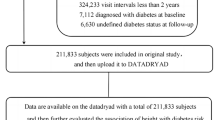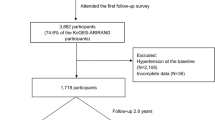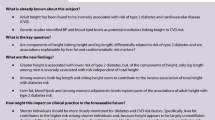Abstract
The aim of this study was to determine the effects of hip circumference (HC) and height on diabetes incidence in non-diabetic first-degree relatives (FDRs) of patients with type 2 diabetes. A total of 1,092 (254 men and 838 women) non-diabetics FDRs ≥ 30 years old in 2003–2005 were followed through 2010 for the occurrence of type 2 diabetes. At baseline and through follow-ups, participants were underwent a standard 75 g 2-h oral glucose tolerance test. The incidence of type 2 diabetes was 17.0 (95% CI: 13.7, 20.2) (13.0 men and 18.1 women) per 1,000 person-year based on 6,015 person-years of follow-up. Height was inversely associated with diabetes incidence. The age-, gender-, and waist-adjusted relative risk (95% CI) of diabetes was 0.54 (0.31, 0.93) for highest quartile of height and 0.59 (0.25, 1.37) for highest quartile of HC compared with lowest quartile. These data indicate that height was inversely associated with diabetes incidence, independently of gender among FDRs of patients with type 2 diabetes.
Similar content being viewed by others
References
Oda E, Kawai R (2010) Body mass index is more strongly associated with hypertension than waist circumference in apparently healthy Japanese men and women. Acta Diabetol 47:309–313
Obesity: preventing and managing the global epidemic. Report of a WHO consultation. World Health Organ Tech Rep Ser 2000; 894:i–xii, 1–253
Vazquez G, Duval S, Jacobs DR Jr, Silventoinen K (2007) Comparison of body mass index, waist circumference, and waist/hip ratio in predicting incident diabetes: a meta-analysis. Epidemiol Rev 29:115–128
Janghorbani M, Amini M (2010) Comparison of body mass index with abdominal obesity indicators and waist-to-stature ratio for prediction of type 2 diabetes: the Isfahan diabetes prevention study. Obes Res Clin Pract 4:e25–e32
Schulze MB, Heidemann C, Schienkiewitz A, Bergmann MM, Hoffmann K, Boeing H (2006) Comparison of anthropometric characteristics in predicting the incidence of type 2 diabetes in the EPIC-potsdam study. Diabetes Care 29:1921–1923
Han TS, McNeill G, Seidell JC, Lean ME (1997) Predicting intra-abdominal fatness from anthropometric measures: the influence of stature. Int J Obes Relat Metab Disord 21:587–593
Pouliot MC, Despres JP, Lemieux S, Moorjani S, Bouchard C, Tremblay A et al (1994) Waist circumference and abdominal sagittal diameter: best simple anthropometric indexes of abdominal visceral adipose tissue accumulation and related cardiovascular risk in men and women. Am J Cardiol 73:460–468
Ashwell M, Cole TJ, Dixon AK (1996) Ratio of waist circumference to height is a strong predictor of intra-abdominal fat. BMJ 313:559–560
Schreiner PJ, Terry JG, Evans GW, Hinson WH, Crouse GR III, Heiss G (1996) Sex-specific associations of magnetic resonance imaging–derived intra-abdominal and subcutaneous fat areas with conventional anthropometric indices. Am J Epidemiol 144:335–345
Snijder MB, Dekker JM, Visser M, Bouter LM, Stehouwer CDA, Kostense PJ et al (2003) Associations of hip and thigh circumferences independent of waist circumference with the incidence of type 2 diabetes: the Hoorn study. Am J Clin Nutr 77:1192–1197
Parker ED, Pereira MA, Stevens J, Folsom AR (2009) Association of hip circumference with incident diabetes and coronary heart disease: the atherosclerosis risk in communities study. Am J Epidemiol 169:837–847
Bozorgmanesh M, Hadaegh F, Zabetian A, Azizi F (2011). Impact of hip circumference and height on incident diabetes: results from 6-year follow-up in the Tehran lipid and glucose study. Diabet Med. doi:10.1111/j.1464-5491.2011.03343.x [Epub ahead of print]
Snijder MB, Zimmet PZ, Visser M, Dekker JM, Seidell JC, Shaw JE (2004) Independent and opposite associations of waist and hip circumferences with diabetes, hypertension and dyslipidemia: the AusDiab study. Int J Obes Relat Metab Disord 28:402–409
Esmaillzadeh A, Mirmiran P, Azadbakht L, Amiri P, Azizi F (2006) Independent and inverse association of hip circumference with metabolic risk factors in Tehranian adult men. Prev Med 42:354–357
Seidell JC, Han TS, Feskens EJ, Lean ME (1997) Narrow hips and broad waist circumferences independently contribute to increased risk of non-insulin-dependent diabetes mellitus. J Intern Med 242:401–406
Hartz AJ, Rupley DC, Rimm AA (1984) The association of girth measurements with disease in 32,856 women. Am J Epidemiol 119:71–80
Lissner L, Björkelund C, Heitmann BL, Seidell JC, Bengtsson C (2001) Larger hip circumference independently predicts health and longevity in a Swedish female cohort. Obes Res 9:644–646
Wang S, Pan W, Hwu C, Ho L, Lo C, Lin S et al (1997) Incidence of NIDDM and the effects of gender, obesity, and hyperinsulinaemia in Taiwan. Diabetologia 40:1431–1438
Njølstad I, Amesen E, Lund-Larsen PG (1998) Sex differences in risk factors for clinical diabetes mellitus in a general population: a 12-year follow-up of the Finnmark Study. Am J Epidemiol 147:49–58
Lorenzo C, Williams K, Stern MP, Haffner SM (2009) Height, ethnicity and the incidence of diabetes: the San Antonio Heart Study. Metabolism 58:1530–1535
Hirschhorn JN, Lindgren CM, Daly MJ, Kirby A, Schaffner SF, Burtt NP et al (2001) Genomewide linkage analysis of stature in multiple populations reveals several regions with evidence of linkage to adult height. Am J Hum Genet 69:106–116
Park HS, Yim KS, Cho SI (2004) Gender differences in familial aggregation of obesity-related phenotypes and dietary intake pattern in Korean families. Ann Epidemiol 14:486–491
Li JK, Ng MC, So WY, Chiu CK, Ozaki R, Tong PC et al (2006) Phenotypic and genetic clustering of diabetes and metabolic syndrome in Chinese families with type 2 diabetes mellitus. Diabetes Metab Res Rev 22:46–52
Ramachandran A, Snehalatha C, Satyavani K, Sivasankari S, Vijay V (2000) Cosegregation of obesity with familial aggregation of type 2 diabetes mellitus. Diabetes Obes Metab 2:149–154
Resnick HE, Halter JB, Valsania P, Lin X (1998) Differential effect of BMI on diabetes risk among black and white Americans. Diabetes Care 21:1828–1835
Nakagami T, Qiao Q, Carstensen B, Nhr-Hansen C, Hu G, Tuomilehto J et al (2003) Age, body mass index and type 2 diabetes-associations modified by ethnicity. Diabetologia 46:1063–1070
Abate N, Chandalia M (2003) The impact of ethnicity on type 2 diabetes. J Diabetes Complications 17:39–58
Executive summary (2008) Standard of medical care in diabetes-2008. Diabetes Care 31:S5–S11
Amini M, Janghorbani M (2007) Diabetes and impaired glucose regulation in first degree relatives of patients with type 2 diabetes in Isfahan, Iran: prevalence and risk factors. Rev Diabet Stud 4:169–176
Janghorbani M, Amini M (2011) Incidence of type 2 diabetes by HbA(1c) and OGTT: the Isfahan diabetes prevention study. Acta Diabetol (in press)
Expert Committee on the Diagnosis and Classification of Diabetes Mellitus (2003) Report of the expert committee on the diagnosis and classification of diabetes mellitus. Diabetes Care Suppl 1:S5–S20
Friedewald WT, Levy RI, Fredrickson DS (1971) Estimation of the concentration of low-density lipoprotein cholesterol in plasma, without use of the preparative ultracentrifuge. Clin Chem 18:499–502
Colditz GA, Willett WC, Stampfer MJ, Manson JE, Hennekens CH, Arky RA et al (1990) Weight as a risk factor for clinical diabetes in women. Am J pidemiol 132:501–513
Asao K, Kao WH, Baptiste-Roberts K, Bandeen-Roche K, Erlinger TP, Brancati FL (2006) Short stature and the risk of adiposity, insulin resistance, and type 2 diabetes in middle age: the Third National Health and Nutrition Examination Survey (NHANES III), 1988–1994. Diabetes Care 29:1632–1637
Sandhu MS, Heald AH, Gibson JM, Cruickshank JK, Dunger DB, Wareham NJ (2002) Circulating concentrations of insulin-like growth factor-I and development of glucose intolerance: a prospective observational study. Lancet 359:1740–1745
Mattila C, Knekt P, Mannisto S, Rissanen H, Laaksonen MA, Montonen J et al (2007) Serum 25-hydroxyvitamin D concentration and subsequent risk of type 2 diabetes. Diabetes Care 30:2569–2570
Kremer R, Campbell PP, Reinhardt T, Gilsanz V (2009) Vitamin D status and its relationship to body fat, final height, and peak bone mass in young women. J Clin Endocrinol Metab 94:67–73
Snijder MB, Dekker JM, Visser M, Yudkin JS, Stehouwer CD, Bouter LM et al (2003) Larger thigh and hip circumferences are associated with better glucose tolerance: the Hoorn study. Obes Res 11:104–111
Conway B, Xiang YB, Villegas R, Zhang X, Li H, Wu X et al (2011) Hip circumference and the risk of type 2 diabetes in middle-aged and elderly men and women: the Shanghai women and Shanghai men’s health studies. Ann Epidemiol 21:358–366
Manolopous K, Karpe F, Frayn K (2010) Gluteofemoral body fat as a determinant of metabolic health. Int J Obes 34:949–959
Snijder MB, Dekker JM, Visser M, Bouter LM, Stehouwer CD, Yudkin JS et al (2004) Trunk fat and leg fat have independent and opposite associations with fasting and postload glucose levels: the Hoorn study. Diabetes Care 27:372–377
Ferreira I, Snijder MB, Twisk JW, van Mechelen W, Kemper HC, Seidell JC et al (2004) Central fat mass versus peripheral fat and lean mass: opposite (adverse versus favorable) associations with arterial stiffness? The Amsterdam growth and health longitudinal study. J Clin Endocrinol Metab 89:2632–2639
Tanko LB, Bagger YZ, Alexandersen P, Larsen PJ, Christiansen C (2003) Peripheral adiposity exhibits an independent dominant antiatherogenic effect in elderly women. Circulation 107:1626–1631
Van Pelt RE, Evans EM, Schechtman KB, Ehsani AA, Kohrt WM (2002) Contributions of total and regional fat mass to risk for cardiovascular disease in older women. Am J Physiol Endocrinol Metab 282:E1023–E1028
Williams MJ, Hunter GR, Kekes-Szabo T, Snyder S, Treuth MS (1997) Regional fat distribution in women and risk of cardiovascular disease. Am J Clin Nutr 65:855–860
Acknowledgments
We are grateful to Mr. Majid Abyar for computer technical assistance. This study could not have been conducted without the contribution of the FDRs of patients with type 2 diabetes who consented to participate.
Conflict of interest
The authors declared no conflict of interest.
Author information
Authors and Affiliations
Corresponding author
Rights and permissions
About this article
Cite this article
Janghorbani, M., Amini, M. Associations of hip circumference and height with incidence of type 2 diabetes: the Isfahan diabetes prevention study. Acta Diabetol 49 (Suppl 1), 107–114 (2012). https://doi.org/10.1007/s00592-011-0351-4
Received:
Accepted:
Published:
Issue Date:
DOI: https://doi.org/10.1007/s00592-011-0351-4




